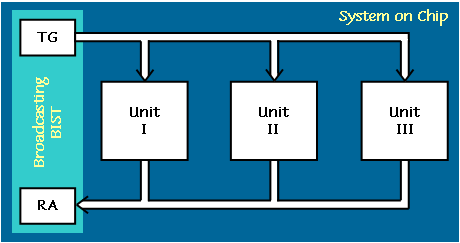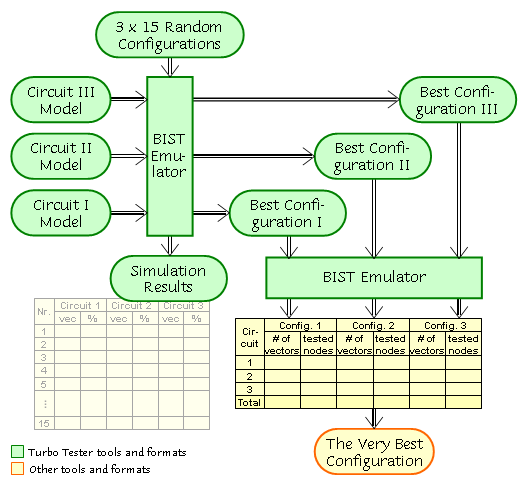 |
|
|
3. BUILT-IN SELF-TEST
 |
|
|
3. BUILT-IN SELF-TEST
Objectives
To explore and to compare different built-in
self-test techniques. To learn finding best LFSR architectures and initial
states (seeds) for BILBO and CSTP methods. To learn finding best combinations
of stored and generated patterns in the Hybrid BIST approach.
Introduction
It is often needed to test an already installed and working device to be sure
that it operates properly. It is not convenient and often not even possible
to take the device off its working place to test it with the external ATE (automated
test equipment). Various embedded test techniques are used in such cases. This
approach is commonly called the built-in self-test (BIST). It usually
implies the presence of one or more built-in linear feedback shift registers
(LFSR) to generate test patterns and analyze acquired signatures. The BILBO
(Built-In Logic Block Observer) method, for example, needs two LFSRs. One for
test generation, another for signature analysis. In the CSTP (Circular Self-Test
Path) just a single LFSR is used for the both purposes.
However, the major drawback of LFSR-based methods is that the test can be too long to be performed within a given period of time. This is due to the properties of test sequences generated by the LFSR. There is a number of so called Hybrid BIST methods designed to fight the problem of too long sequences. One of them, "store & generate" implies the use of some stored seeds for the LFSR. From these seeds a set of smaller sequences is generated. The total length of them is much less than the length of the single test sequence generated by the BILBO or CSTP.
Work description
Suppose, we have a system on a chip with a number of functional units. Three
of them are combinational circuits, which must be tested by a single BIST device
to save the silicon area and hardware costs. To do so, we are going to use the
"broadcasting BIST" technique which is illustrated in the following
picture.

This technique implies that the test generator (TG) sends simultaneously the same vectors to all the units under test. The output responses (all together) are analyzed in the response analyzer (RA). The particular implementation of TG and RA may depend on the BIST architecture (like BILBO or CSTP). Our task is to choose the architecture and the initial state of the LFSR in TG so that it would generate a good test sequence for all the three circuits simultaneously. One of the possible approaches to solve this problem is the following.

First, we select a good configuration (architecture-seed pair) for each circuit separately. For that we use 3 times 15 random configurations, simulate them, and register the simulation results. Using these results we choose the three best configurations. Then we simulate all of them one after another with each of the three circuits and register results again. Finally we must choose the best configuration - an architecture-seed pair that gives the highest total fault coverage or/and the shortest test length. During our work we will examine both BILBO and CSTP methods and then compare their efficiency.
Another problem to be solved during this work is to find an optimal (or suitable) to given constraints combination of stored seeds and generated test patterns for "store & generate" - one of the techniques in Hybrid BIST approach. Suppose we have another chip with a circuit that has to be periodically tested. At the same time, we have a strictly limited testing time and therefore cannot use a conventional LFSR for test generation. There is also a limitation of a chip space. In these harsh conditions we have to find the solution anyway. So, our task can be bilateral: a) to find a minimum number of good seeds when the upper test length limit L is known or b) to find such seeds that give the shortest total test length if the maximim number of seeds S is given. The task can be even tougher if we are requested to minimize the both parameters.
Steps
Steps
The circuits that we use in the exapmle are given in Table 1 below. The maximal numbers of inputs and outputs among all of them are 36 and 25 respectively. This means that the minimal length of the TPG must be 36 bit and the minimal length of the SA is 25 bit. For CSTP, the LFSR's minimal length must be taken as 36 bit.
| |
|
|
|
| |
|
|
|
| |
|
|
|
| |
|
|
|
To generate a pseudo random sequence by the BIST emulator in BILBO mode write: bist -rand -glen 36 -alen 25 -optimize -simul bilbo c17. We have made a lot of experiments with different random (-rand option) configurations for c17 circuit and registered the results, which (15 of them as it is required) we give in Table 2 . The simulation has shown that it is always possible to achieve 100% coverage with any chosen BILBO architecture and random seed for our circuit. What changes from experiment to experiment is the test length. The best one is 7 vectors only (highlighted in green). The corresponding configuration (architecture/seeds), the nr. 6 configuration is chosen as the best for this circuit (since the coverage has always been the same). It is given in Table 3.
| |
Circuit
1 |
Circuit
2 |
Circuit
3 |
|||
| Nr. |
#
of vectors |
Fault
cover. % |
#
of vectors |
Fault
cover. % |
#
of vectors |
Fault
cover. % |
|
1 |
11 |
100.00 |
435 |
93.019 |
5582 |
99.480 |
|
2 |
19 |
100.00 |
427 |
93.019 |
5711 |
99.480 |
| 3 |
21 |
100.00 |
589 |
93.019 |
8875 |
99.480 |
| 4 |
25 |
100.00 |
314 |
93.019 |
9842 |
99.307 |
| 5 |
19 |
100.00 |
1459 |
93.019 |
6119 |
99.480 |
| 6 |
7 |
100.00 |
363 |
93.019 |
5075 |
99.480 |
| 7 |
12 |
100.00 |
1473 |
93.019 |
8876 |
99.480 |
| 8 |
20 |
100.00 |
1675 |
92.857 |
9818 |
99.480 |
| 9 |
19 |
100.00 |
982 |
93.019 |
4034 |
99.480 |
| 10 |
45 |
100.00 |
1671 |
93.019 |
7415 |
99.480 |
| 11 |
14 |
100.00 |
300 |
91.396 |
5671 |
98.210 |
| 12 |
37 |
100.00 |
767 |
93.019 |
8771 |
99.365 |
| 13 |
21 |
100.00 |
656 |
93.019 |
5718 |
99.480 |
| 14 |
10 |
100.00 |
1405 |
93.019 |
6781 |
99.480 |
| 15 |
18 |
100.00 |
867 |
93.019 |
4761 |
99.480 |
We continued then the experiments with the two remaining circuits in the similar way. In the case of c432 circuit, the best vector count was 300. However, at the same time the fault coverage was lower than in other cases. Therefore, we selected the best test length among the results with the best fault coverage. It was the case nr. 4. Again, we put it in Table 3. The experiments with c1908 has shown that the corresponding configuration nr. 9 is the best. For each of the given circuits we selected -count option for the BIST emulator based on recommendation given here. For c432 we used -count 1500, while for c1908 -count 10000. When we use -count and -optimize options together we force the emulator to generate the specified number of vectors or stop at some point if the coverage does not improve any further. When you will be performing your experiments do not forget to copy the file withe the best so far BIST configuration to another file with an arbitrary name (e.g. cp c432.tst c432.best)! Otherwise, it will be each time overwritten!
| |
|
|
TPG Architecture SA Seed SA Architecture |
| |
7 |
100.00 |
110000100110101001111111011010011110 101011011100100111001011110001011001 0010010001001010010010010 1101000010010010110001110 |
| |
314 |
93.019478 |
110000100110101001100001001101111110 101011011100100101000100010011011001 0010010001001010001110001 1101000010010010101110010 |
| |
4034 |
99.480370 |
110000100110101001110111110000011110 101011011100100101100110001010111001 0010010001001010100000111 1101000010010010111010101 |
As it was stated above, each time we were taking a new random BIST configuration and simulated it. However, there is another good strategy to acquire "good" BIST configurations. Propably, you will notice from your experiments that "good" polynomials are always very similar. So, this means that it should be possible to generate new better polynomials by introducing minor changes into initial ones. You can try this method as well. Likely, it will give you better results within shorter time!
To apply the first configuration to c432 circuit write: bist -ginit 110000100110101001111111011010011110 -gpoly 101011011100100111001011110001011001 -ainit 0010010001001010010010010 -apoly 1101000010010010110001110 -optimize -simul bilbo -count 10000 c432. All other configurations are applied to all the circuits in the similar way.
The results of the simulation are given in Table 4 below. It shows the test lengthes and fault coverage for each BIST configuration and each circuit. The best length for each particular circuit is highlighted, again, by green. The fault coverage is given now as the number of tested nodes (not the percentage). This is useful for calculation of the total coverage, which is given in the last row of the Table 4. This row also shows the maximal test length for each configuration. The best one is highlighted by green.
| Config: |
Configuration
1 |
Configuration
2 |
Configuration
3 |
|||
| Circuit |
#
of vectors |
Tested
nodes |
#
of vectors |
Tested
nodes |
#
of vectors |
Tested
nodes |
|
c17 |
11 |
22 |
19 |
22 |
19 |
22 |
|
c432 |
589 |
573 |
314 |
573 |
1459 |
573 |
| c1908 |
7415 |
1723 |
8875 |
1723 |
4034 |
1723 |
|
Max/Total: |
7415 |
2318 |
8875 |
2318 |
4034 |
2318 |
Last update: 28 July, 2004